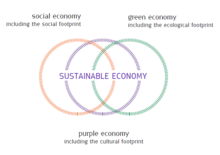Purple economy
The purple economy is that part of the economy which contributes to sustainable development by promoting the cultural potential of goods and services.
“The purple economy refers to taking account of cultural aspects in economics. It designates an economy that adapts to the human diversity in globalization and that relies on the cultural dimension to give value to goods and services.”[1] These two trends, one vertical and one horizontal, feed one another. In fact the growth in the cultural component attached to products is linked to each territory’s cultural vitality.
Scope
The purple economy is multidisciplinary, in that it enriches all goods and services by capitalizing on the cultural dimension inherent to every sector.
If differs from the cultural economy, which is sector-based.
In June 2013, the conclusions of a first inter-institutional working group on the purple economy, formed of experts from UNESCO, the OECD, the International Organisation of La Francophonie, French ministries, various companies and civil society. That document underscored the impact of the phenomenon of culturalization, which now affects the entire economy, with follow-on effects on employment and training. The report differentiates between purple jobs and purplifying professions: the former are directly linked to the cultural environment by their very purpose (like town planners and developers), while the latter are merely caused to transform under the effect of culturalization (such as positions in human resources or in marketing and communications).[2]
Origin
The term first appeared in 2011, in France, in a manifest[3] published on Le Monde.fr. The signatories[4] included the board members of the association Diversum,[5] which organized the first International Purple Economy Forum under the patronage of UNESCO, the European Parliament and the European Commission.[6]
Connection to sustainable development

The purple economy emphasizes the presence of externalities: the cultural environment from which agents draw and on which, in return, they leave their own footprints is a common good. As a result, the purple economy sees culture as a sustainable development issue.
This issue is just one of the different components of sustainable development, alongside concerns relating to the natural environment (green economy) and to the social environment (social economy). The complementary nature of these aspects of the sustainable economy was reaffirmed in a call[7][8] published by Le Monde Économie in 2015, leading up to the 21st United Nations Conference on Climate Change.
See also
- Sustainable development
- Cultural diversity
- Knowledge economy
- Globalization
- Cognitive-cultural economy
Notes and references
- ↑ Le Journal des Arts
- ↑ Conclusions of the first inter-institutional working group on the purple economy
- ↑ Le Monde.fr
- ↑ Jean-Jacques Aillagon, Bruno Bourg-Broc, Bernard Cerquiglini, Gilles Ciment, Joëlle Garriaud-Maylam, José Luís Dicenta Ballester, Renaud Donnedieu de Vabres, Mercedes Erra, Pierre-Antoine Gailly, Jérôme Gouadain, Claudie Haigneré, Jean-Hervé Lorenzi, Jean Musitelli, Alain-Dominique Perrin, Odile Quintin, Bernard Ramanantsoa, Jean-François Rial, Pierre Simon
- ↑ Bernard Cerquiglini, Joëlle Garriaud-Maylam, Jérôme Gouadain, Jean-Hervé Lorenzi, Jean Musitelli, Odile Quintin, Pierre Simon, source http://www.diversum.net/fichiers/File/Asso_diversum_10-05-2010_en.pdf
- ↑ Website of the International Purple Economy Forum
- ↑ Le Monde Économie
- ↑ By: Pierre Bellon, Véronique Cayla, Bertrand Collomb, Pascal Colombani, Mercedes Erra, Emmanuel Faber, Pierre Fonlupt, Jean-Baptiste de Foucauld, Pierre-Antoine Gailly, Jérôme Gouadain, Philippe d'Iribarne, Pascal Lamy, Gilles Lipovetsky, Jean-Pierre Masseret, Gérard Mestrallet, Radu Mihăileanu, Jean Musitelli, Grégoire Postel-Vinay, Jean-Jack Queyranne, Odile Quintin, Bernard Ramanantsoa, Jean-François Rial, Franck Riboud, Michel de Rosen, Pierre Simon.